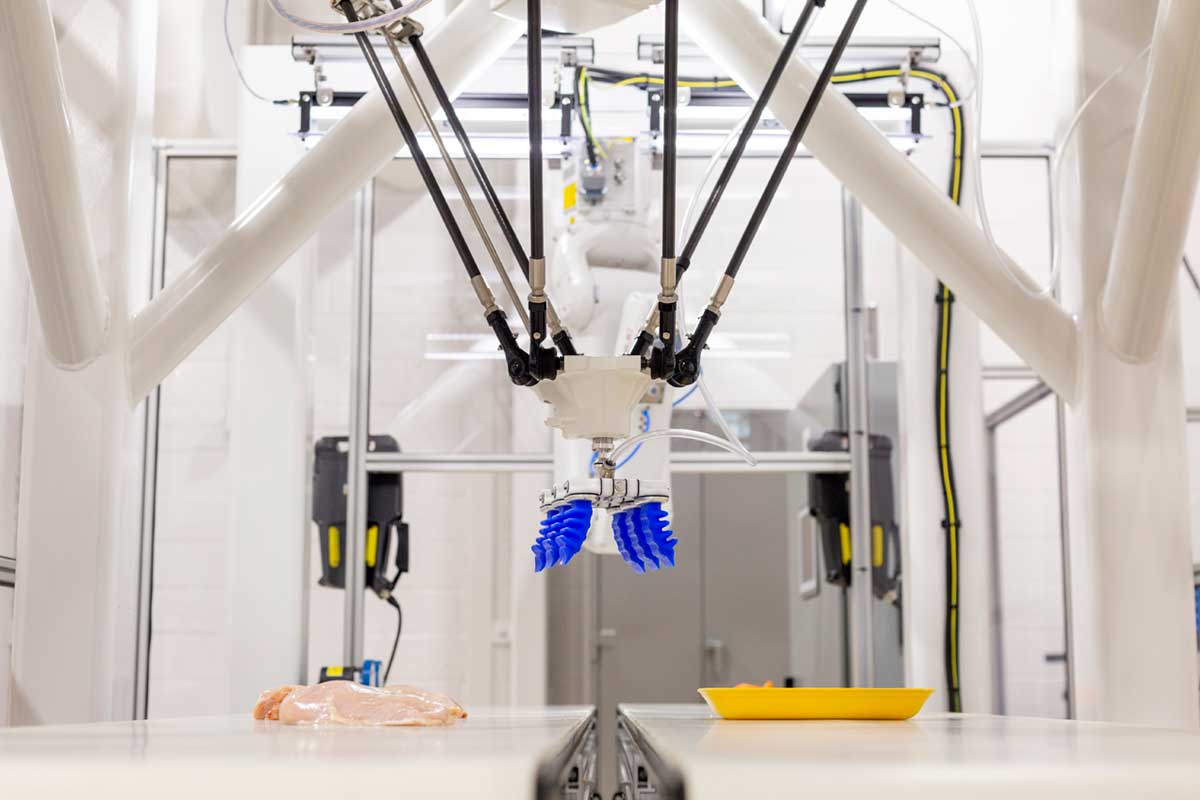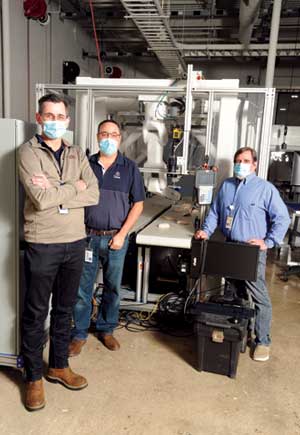On Aug. 8, 2019, Tyson Foods Inc. opened the Tyson Manufacturing Automation Center (TMAC) in downtown Springdale, Ark. The 26,000-square-foot building formerly served as a large truck maintenance and service facility and now, having undergone a renovation, represents Tyson’s commitment to evolving its global operations and to enhancing the community and the lives Springdale’s residents.
“It kind of fell into disrepair over the years,” said Marty Linn, an engineer and director of TMAC. “As part of the overall revitalization of Springdale, Tyson has invested in buildings and facilities in downtown Springdale while creating new jobs in the area.”
Tyson first revamped an adjacent building housing the company’s Information Technology Group, which shares architectural features with TMAC. Tyson intended the complementary look of the buildings and landscaping to create a campus-like feel in the area and to draw younger, tech-savvy people to the fields of automation and IT.
A roughly 35-mile biking and multiuse trail called the Razorback Greenway runs directly through the grounds of TMAC and the Information Technology Group, adding to the allure and draw for the next generation of technology and engineering workers, and production and operations experts Tyson seeks to employ.
“Since we’re in downtown Springdale and investing a lot in the revitalization of this area, we also want to make it convenient for those team members that are able to perhaps bike to work,” Linn said.
When the weather permits, Doug Foreman, director of engineering and technology development, utilizes the trail regularly to pedal himself to work.
“It’s about a half mile from my house and I can actually get on the trail and it runs right behind our building here,” Foreman said.
Once through the reception area, locker areas with bike racks and showers accentuate the innovative approach to the facility’s design and the campus-like atmosphere of the two buildings and land they occupy. With office space for about 30 people, the number of onsite employees fluctuates, and on most days during the coronavirus (COVID-19) pandemic, 10 to 15 are at the facility. Foreman quickly points out that engineers play less of a role than one might think.
“What we have is a lot of production experts that work here,” he said. “To have a good working solution from an automation perspective, you have to marry the technology up with a production expert that understands the product, the process and the environment, so when we do create a solution, we know and have a good understanding of what the output of that solution should be.”
“It’s really a harmony and marriage between the processing requirements and the technology,” Linn added.
When Tyson, Linn and Foreman think of TMAC and describe its purpose, they use an acronym: CITTI.

By the letter
The first letter in CITTI stands for collaboration. TMAC provides Tyson a facility for professionals from plants, engineers from both Tyson and its equipment suppliers to collaborate on manufacturing, processing, packaging, etc. The collaboration with technology providers through TMAC allows Tyson to try solutions out before equipment goes to a plant.
“That’s really the key fundamental for us,” Linn said. “Collaboration is a big part of the process of developing and implementing new technology.”
The first I in CITTI represents innovation. One of Tyson’s top goals for TMAC is to develop innovative and groundbreaking solutions the industry has not historically used or even seen. The first T is test. The automation facility acts as a testing ground for new equipment and technologies, giving Tyson the opportunity to “tune,” and “dial in” the solutions born at TMAC before deployment into production plants.
Training, the second T, gives the solutions created in TMAC the greatest odds of success after deployment into the field. Roughly a quarter of the TMAC facility consists of training labs for Tyson team members to learn the solutions and experience the technology before placement in a plant. This provides the knowledge they need use and support the technology, and keep it running in the plant.
“The last I in CITTI is for inspiration,” Linn said. “We think that this facility and the way we’re trying to engage the community and trying to engage the rest of the company is an inspiration. We’re doing high-tech things here. There’s a place here for high school and college-aged kids to say, ‘Hey, if I learn about technology there’s actually jobs here. There are a lot of things that we can do within the field of automation and technology right here in the Midwest.’”
TMAC currently focuses much of its training and development of technology and automation on vision systems, robotics and methods to integrate the two.
The layout
Tyson designed the biggest and first room seen when entering the automation center with a large bay door leftover from its time as a service center for Tyson trucks. This allows movement of large equipment in and out quickly. Electrical power service and airlines live in an overhead duct system on the ceiling of the large room giving engineers, production and processing experts, and technology providers from both Tyson and its suppliers the ability to set up and reconfigure depending on what is needed to accommodate specific machines and technology.
They can then test, train team members, move the machines out and prep for the next project with efficiency.
“Without actually needing to bring in outside electricians we can easily tap into our duct system and drop power right down to the equipment, wherever we need to place it,” Foreman said.
The room however is not without a warm, aged character.
“This concrete is actually 50 or 60 years old,” Linn said. “What’s interesting, as this is a former truck shop, and this is kind of a silly point, but we sanded and polished the cement and there are still footprints here in the floor. It’s like seeing dinosaur tracks.”
“Whatever solvent he had on his shoes, it was pretty strong,” Foreman added.
Scratches and gouges in the floor remain visible and two large glass panels that look like bay doors accompany the functional bay door to let in natural light and enhance the look while maintaining the original feel of the building in the 4,000-square-foot room.

The building facilitates the collaboration piece of its mission through mixed tenant space. Tyson provides office space and storage for outside suppliers and technology providers who come to TMAC to work on projects.
“We wanted to give them an office space that they could come do email, do meetings, do whatever it is they need to do from an office perspective,” Linn said.
For training, TMAC uses a formal training classroom, and two hands on training areas containing workbenches and tools for various situations and equipment, as well as a training overflow area. Examples of what Linn calls “base training” include electrical controls, motor controls, basic pneumatics, basic hydraulics and some robot programming and robot maintenance.
“The second part of that is very, very specific training in the systems and technologies that are actually going into the plants,” Linn said. “It’s training the support staff and technicians in the core things, as well as the specific things that they’re going to see in their plant.”
Foreman noted an apprehension about robotics in the industry due limited numbers currently in Tyson processing plants.
“Just to get them in here, get them familiar, get them comfortable working around robots is really an important thing,” Foreman added “So when the robots show up in the facility, they’ve got a comfort level to keep them up and running and make sure the plant is going to operate properly.”
Also, the building has a small shop capable of cutting, drilling, welding, sandblasting and some minor fabrication with a focus on things like end of arm tools for robots.
The innovation labs
The first of the two innovation labs at TMAC was set up with technologies used for permanent members of the facility to develop different processes quickly and efficiently because the equipment is there. The lab allows for technicians to step in and try out end of arm tools, vision systems, etc.
One of Tyson’s suppliers brought in a robot with a vision system for the facility’s grand opening. Tyson kept the system at TMAC, and it currently lives in the first innovation lab. The machine demonstrates the technology of a robot and a vision system working together to separate and sort colors. A color scanner above the robot identifies different colored pills. Then the robot separates the pills and places them in each tube designated for each color.
“The idea is that color is really important to us, being able to separate perceived defects and identify other anomalies based on color,” Linn said. “That’s one of the technologies we’re spending a lot of time looking at, machine vision and using that with robotics to help us do process quality control.”

“This particular room is an environmental wash down room,” Linn said. “You can take the temp down to about 40°F and set up equipment that we’re planning to take to our production environment and put it in the same conditions environmentally that it will see in production. We’re trying to really reduce the risk to our production plants by making sure the robustness of the equipment is really there.”
Most suppliers do not have rooms with the different power amperages, air lines, water lines, etc., that various pieces and assemblies of heavy processing equipment need to run and be tested as if it were in the field. In addition, manipulation of the environment stacks another layer to TMAC’s capabilities. Tyson designs and builds operational facilities to utilize their entire footprint. This rules out the company’s ability to test and vet equipment in-house at a plant.
The final layer to TMAC’s value comes in the form of proprietary development. Without a facility like TMAC, it would be virtually impossible to develop proprietary solutions away from public view, making it a true gem in the industry.
“It’s really one of the critical rooms that we have in terms of developing proprietary equipment,” Foreman said. “It’s a great space for that and is really helpful to us.”


